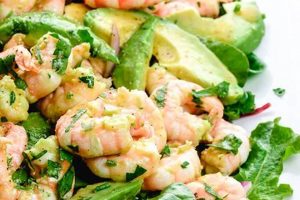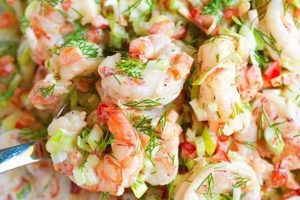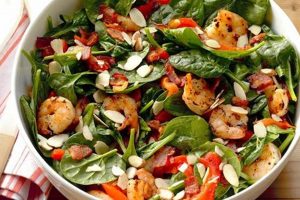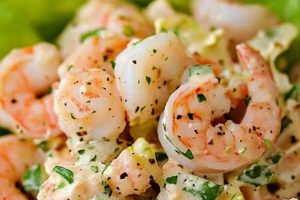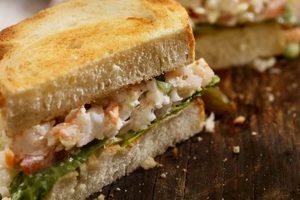A dish featuring cooked shrimp combined with a rich, emulsified sauce, typically mayonnaise-based, often includes additional ingredients such as celery, onion, herbs, and spices. Variations exist, incorporating different types of mayonnaise, yogurt, or sour cream, along with diverse flavor profiles achieved through ingredients like lemon juice, Dijon mustard, or Old Bay seasoning. This versatile dish can be enjoyed as a sandwich filling, served over lettuce as a salad, or presented as an appetizer with crackers or crudits.
A simple yet elegant option for lunches, picnics, or light dinners, this type of seafood salad provides a good source of protein and omega-3 fatty acids. Its adaptability lends itself well to diverse palates and dietary preferences, with variations ranging from classic preparations to innovative combinations featuring global flavors. Historically, variations of seafood salads, including those with shrimp, have appeared in cookbooks since the 19th century, evolving alongside changing tastes and ingredient availability.
This exploration will delve further into specific ingredient combinations, preparation techniques, and serving suggestions for creating delicious and satisfying seafood salads.
Tips for Exceptional Shrimp Salad
Achieving a superior salad hinges on careful attention to detail, from ingredient selection to preparation techniques. The following tips offer guidance for creating a dish that is both flavorful and visually appealing.
Tip 1: Shrimp Selection and Preparation: Opt for high-quality, fresh or properly frozen shrimp. Overcooked shrimp become tough; cook just until pink and opaque. Proper chilling prevents bacterial growth and enhances flavor.
Tip 2: Enhancing the Creamy Base: While mayonnaise forms the foundation, consider incorporating complementary elements like sour cream or Greek yogurt for added tang and richness. A touch of Dijon mustard adds complexity.
Tip 3: Balancing Flavors: Fresh herbs such as dill, chives, or parsley provide brightness. A squeeze of lemon juice or a dash of hot sauce introduces acidity and depth. Finely diced red onion or shallots contribute a subtle sharpness.
Tip 4: Achieving Optimal Texture: Dice ingredients uniformly for visual appeal and even distribution of flavor. Avoid over-chopping, which can lead to a mushy texture.
Tip 5: Seasoning Strategically: Seasoning should be layered. Salt and pepper the shrimp during cooking. Incorporate additional seasoning into the creamy base, adjusting to taste.
Tip 6: Proper Chilling: Allow the salad to chill thoroughly before serving. This allows the flavors to meld and enhances the creamy texture.
Tip 7: Presentation Matters: Consider serving the salad on crisp lettuce cups, in a scooped-out avocado, or with crackers or crudits. Garnish with fresh herbs or a sprinkle of paprika for visual appeal.
By following these tips, one can elevate a simple shrimp salad to a culinary delight. Attention to these details ensures a flavorful, well-balanced, and aesthetically pleasing dish.
These insights provide a foundation for crafting a memorable seafood salad experience. Experimentation with flavors and presentation further personalizes this versatile dish.
1. High-quality shrimp
The foundation of a successful creamy shrimp salad rests upon the selection of high-quality shrimp. This ingredient significantly influences the final dish’s flavor, texture, and overall appeal. Understanding the characteristics of superior shrimp allows for informed choices that elevate the culinary experience.
- Freshness and Flavor:
Fresh shrimp possess a clean, sweet aroma reminiscent of the sea, lacking any fishy or ammonia-like odor. Their flavor is delicate and slightly sweet, not overpowering. In a creamy shrimp salad, this inherent sweetness complements the richness of the mayonnaise and other ingredients, creating a balanced and nuanced flavor profile. Using frozen shrimp is acceptable, but ensure they are properly thawed and patted dry before incorporating them into the salad.
- Texture and Firmness:
High-quality shrimp exhibit a firm texture. They should feel slightly springy to the touch and should not be mushy or slimy. This firmness ensures that the shrimp maintain their integrity when mixed with the other ingredients, preventing a watery or unappetizing texture in the finished salad.
- Appearance and Color:
The appearance of the shrimp offers visual cues to their quality. Fresh shrimp should appear translucent and glossy, with a natural pinkish hue. Avoid shrimp that appear discolored, dull, or have black spots, as these may indicate spoilage. The vibrant color of high-quality shrimp enhances the visual appeal of the finished salad.
- Sourcing and Sustainability:
Consideration of sourcing practices contributes to both ethical consumption and quality. Sustainably harvested shrimp, often labeled with certifications, ensures responsible fishing practices. These shrimp are more likely to be fresh and flavorful due to careful handling and processing throughout the supply chain. Choosing sustainable options supports responsible aquaculture and ocean health.
By prioritizing these facets of shrimp selection, one ensures a creamy shrimp salad of superior quality. The inherent characteristics of the shrimp contribute significantly to the overall flavor, texture, and aesthetic appeal of the dish. The investment in high-quality ingredients translates directly into a more satisfying culinary experience.
2. Creamy Base
The creamy base forms the essential binding element in a creamy shrimp salad recipe, impacting texture, flavor, and overall enjoyment. This component contributes significantly to the salad’s richness, moisture, and ability to cohesively incorporate other ingredients. A well-executed creamy base elevates the dish beyond a simple mixture of components into a harmonious blend of flavors and textures.
Classic recipes rely on mayonnaise as the primary ingredient, offering a neutral backdrop that allows the delicate flavor of shrimp and other additions to shine. Variations, however, achieve complexity through additions such as sour cream, Greek yogurt, crme frache, or a combination thereof. These additions introduce subtle tanginess, enhance the creamy texture, and contribute to a lighter mouthfeel. The creamy base also serves as a vehicle for flavor incorporation. Ingredients like Dijon mustard, horseradish, lemon juice, or hot sauce, whisked into the base, distribute flavor evenly throughout the salad. The quantity and type of creamy base directly influence the final product. Too little results in a dry, disjointed salad, while an excess can overwhelm the other flavors. A balanced approach ensures the creamy base complements, rather than dominates, the overall composition.
Practical applications demonstrate the creamy base’s versatility. A classic example utilizes mayonnaise blended with a touch of Dijon mustard and lemon juice. This combination provides a tangy, balanced foundation that complements the shrimp’s sweetness. A richer variation incorporates sour cream and fresh herbs, offering a decadent, layered flavor profile. Challenges arise when the creamy base lacks balance. An overly acidic base can mask the shrimp’s flavor, while an excessively thick base creates a heavy, unappetizing texture. Careful consideration of ingredient ratios and flavor combinations ensures a successful and enjoyable creamy shrimp salad.
3. Flavorful additions
Flavorful additions play a crucial role in elevating a creamy shrimp salad recipe from simple to exceptional. These ingredients provide depth, complexity, and textural contrast, transforming the dish into a multi-sensory experience. The careful selection and balance of these additions directly impact the final product’s overall appeal.
Classic additions include finely diced celery for a refreshing crunch, red onion for a subtle bite, and fresh herbs such as dill, parsley, or chives for aromatic brightness. These elements create a balanced flavor profile, complementing the sweetness of the shrimp and the richness of the creamy base. Beyond these traditional choices, a wide array of ingredients can enhance the salad. Consider incorporating chopped bell peppers for sweetness and color, water chestnuts for a crisp texture, or capers for a briny, salty note. Spices and seasonings, such as Old Bay, paprika, or cayenne pepper, further contribute to the complexity of flavors. For example, a Southwestern-inspired variation might include chopped cilantro, jalapeo, and a squeeze of lime, while a Mediterranean version could feature Kalamata olives, feta cheese, and oregano.
A key consideration when incorporating flavorful additions is achieving balance. Overpowering ingredients can mask the delicate flavor of the shrimp. The goal is to create a harmonious blend where each element complements the others, resulting in a well-rounded and satisfying flavor profile. Challenges can arise from improper ingredient preparation. Overly large pieces of vegetables can disrupt the salad’s texture, while wilted herbs diminish their aromatic contribution. Careful attention to detail, including proper chopping and ingredient freshness, ensures the flavorful additions enhance the overall quality of the creamy shrimp salad. This understanding allows for greater culinary creativity and customization, offering a range of flavor possibilities to suit individual preferences.
4. Proper Seasoning
Proper seasoning is paramount in a creamy shrimp salad recipe, significantly impacting the final dish’s overall flavor profile. It elevates the inherent flavors of the shrimp and other ingredients, creating a balanced and palatable experience. Understanding the nuances of seasoning allows for a more nuanced and satisfying culinary outcome.
- Salt and Pepper as Foundation:
Salt and freshly ground black pepper serve as the foundational seasoning elements in virtually any culinary creation, including creamy shrimp salad. Salt enhances the natural sweetness of the shrimp and other ingredients, while pepper adds a subtle bite and complexity. The quantity of each depends on individual preference and the saltiness of other components, such as capers or olives. A general guideline involves seasoning the shrimp lightly during the cooking process and then adjusting the seasoning in the final salad mixture.
- Enhancing with Acidity:
Acidity plays a crucial role in balancing the richness of the creamy base and brightening the overall flavor profile. A squeeze of lemon juice, a splash of white wine vinegar, or a dash of hot sauce can add a vibrant, tangy dimension to the salad. The choice of acidic ingredient depends on the desired flavor profile and can range from subtle brightness to a more pronounced zest. Over-acidity can mask the delicate flavor of the shrimp, so a balanced approach is essential.
- Herbs and Spices for Complexity:
Fresh herbs and spices offer a wide range of flavor possibilities, contributing depth and complexity to the creamy shrimp salad. Fresh dill, parsley, chives, or tarragon can add bright, herbaceous notes, while dried spices like Old Bay seasoning, paprika, or cayenne pepper offer more robust and savory nuances. The choice of herbs and spices depends on the desired flavor profile and can range from classic combinations to more adventurous blends.
- Layering Flavors for Depth:
Effective seasoning involves layering flavors throughout the preparation process. Seasoning the shrimp during cooking ensures the flavor penetrates the flesh. Additional seasoning incorporated into the creamy base distributes flavor evenly throughout the salad. A final touch of seasoning just before serving allows for adjustments based on the overall taste. This layered approach creates a more complex and well-developed flavor profile.
Proper seasoning is not merely an afterthought but an integral aspect of crafting a delicious creamy shrimp salad. The careful balance of salt, pepper, acidity, herbs, and spices elevates the dish from simple to exceptional, ensuring a more enjoyable and satisfying culinary experience.
5. Textural Balance
Textural balance is a critical aspect of a successful creamy shrimp salad recipe, contributing significantly to the overall enjoyment of the dish. A pleasing interplay of textures elevates the eating experience, while a monotonous or unbalanced texture can detract from even the most flavorful ingredients. This exploration delves into the components of textural balance in a creamy shrimp salad, highlighting their individual contributions and collective impact.
- Shrimp Texture as a Foundation:
Properly cooked shrimp offer a firm, slightly springy texture that contrasts with the creamy base. Overcooked shrimp become rubbery and detract from the desired textural contrast. Achieving this foundational element requires careful attention to cooking time and temperature.
- Creamy Base Consistency:
The creamy base, typically mayonnaise-based, provides a smooth, rich counterpoint to the firmer textures of the shrimp and other additions. The consistency of this base plays a key role in the overall textural balance. An overly thick base can create a heavy, cloying mouthfeel, while a thin base lacks the necessary richness and binding power.
- Contrasting Elements from Additions:
Ingredients like celery, red onion, and water chestnuts introduce contrasting textures that prevent the salad from becoming monotonous. Celery offers a crisp, refreshing crunch, while finely diced red onion provides a subtle bite. Water chestnuts contribute a unique, slightly starchy crispness. These additions create points of interest and enhance the overall sensory experience.
- Impact of Chopping Techniques:
Chopping techniques significantly influence the textural balance of the salad. Uniformly diced ingredients ensure a consistent texture throughout, preventing large chunks from overwhelming the other components. Over-chopping, however, can result in a mushy texture, diminishing the desirable contrast. Careful attention to knife skills ensures the ingredients contribute appropriately to the overall textural profile.
Achieving textural balance in a creamy shrimp salad requires careful consideration of each component’s contribution. The interplay of texturesfrom the firm shrimp to the smooth creamy base and the crisp additionscreates a dynamic and satisfying eating experience. A lack of attention to this detail can result in a dish that, while perhaps flavorful, lacks the nuanced textural complexity that elevates it from simple to exceptional.
6. Serving Suggestions
Serving suggestions are integral to the overall enjoyment of a creamy shrimp salad recipe. Presentation enhances the dining experience, influencing perceptions of flavor and appeal. Thoughtful consideration of serving options elevates the dish from a simple meal to a more refined culinary offering.
- Classic Bread Options:
Serving creamy shrimp salad on bread is a timeless choice. Options range from classic white bread and croissants to whole-wheat varieties and crusty rolls. Toasted bread adds a textural contrast and prevents sogginess. Mini croissants or slider buns offer a more elegant presentation for appetizers or parties. The bread choice should complement the salad’s flavors without overpowering them.
- Fresh and Vibrant Greens:
Presenting creamy shrimp salad atop a bed of fresh greens adds a refreshing element and visual appeal. Crisp lettuce cups, such as butter lettuce or romaine hearts, provide a light and refreshing vessel. Arugula or spinach offer a peppery counterpoint to the creamy richness. This serving style caters to lighter appetites and provides a more balanced nutritional profile.
- Creative Vessels and Accompaniments:
Beyond traditional options, creative vessels enhance presentation and flavor. Avocado halves, hollowed-out tomatoes, or bell peppers create visually appealing and flavorful serving options. Crackers, crudits, or chips offer convenient and complementary accompaniments, providing textural contrast. These choices add an element of sophistication and allow for individual portioning.
- Garnishes and Finishing Touches:
Garnishes provide the final flourish, enhancing visual appeal and adding subtle flavor nuances. Fresh herbs, such as dill or chives, offer a pop of color and aromatic complexity. A sprinkle of paprika or a drizzle of olive oil adds visual interest. Lemon wedges provide an optional burst of acidity. These finishing touches demonstrate attention to detail and elevate the overall presentation.
Careful consideration of serving suggestions elevates the creamy shrimp salad experience. The choice of bread, greens, vessels, and garnishes influences not only the presentation but also the overall perception of flavor and enjoyment. A thoughtful approach to serving transforms a simple dish into a more refined and satisfying culinary creation.
Frequently Asked Questions
This section addresses common inquiries regarding creamy shrimp salad recipes, providing concise and informative responses to facilitate a deeper understanding of preparation techniques and ingredient selection.
Question 1: What type of shrimp is best suited for creamy shrimp salad?
While various shrimp varieties work, smaller sizes like 41/50 count (number per pound) are ideal. Larger shrimp can be chopped to the desired size. Fresh, high-quality shrimp deliver optimal flavor, but frozen shrimp, thawed correctly, offer a convenient alternative.
Question 2: Can the mayonnaise be substituted with healthier alternatives?
Plain Greek yogurt or a mixture of yogurt and mayonnaise offer a lighter, tangier alternative to traditional mayonnaise. Avocado can also provide creaminess and healthy fats. The substitution impacts the overall flavor and calorie content.
Question 3: How long can creamy shrimp salad be stored?
Refrigerated in an airtight container, it typically lasts for 3-4 days. Consume within 2 days for optimal flavor and freshness. Avoid storing at room temperature for extended periods to minimize bacterial growth.
Question 4: How can one prevent the salad from becoming watery?
Ensure the shrimp and vegetables are thoroughly drained before mixing. Patting the shrimp dry with paper towels further reduces excess moisture. Do not over-chop the ingredients, as this releases additional liquid.
Question 5: What can be added to enhance the flavor profile?
Fresh herbs, such as dill, chives, or parsley, brighten the flavor. Lemon juice or vinegar adds a touch of acidity. Spices like Old Bay seasoning, paprika, or cayenne pepper provide depth and complexity. Incorporating ingredients like capers, olives, or chopped pickles introduce briny and savory notes.
Question 6: Can creamy shrimp salad be frozen?
Freezing is generally not recommended. The mayonnaise-based dressing can separate upon thawing, resulting in an undesirable texture. Freezing also affects the shrimp’s texture, making it less firm.
Understanding these key aspects of preparation and storage ensures a higher likelihood of success when creating creamy shrimp salad. Experimentation with different flavor combinations and serving suggestions further personalizes the culinary experience.
This FAQ section provides a basis for troubleshooting common challenges. Further exploration into specific recipe variations and culinary techniques can enhance one’s mastery of this versatile dish.
Conclusion
Creamy shrimp salad recipes offer a versatile and adaptable culinary canvas. From the selection of high-quality shrimp and the nuances of the creamy base to the incorporation of flavorful additions and the importance of proper seasoning, each element contributes to the final product’s overall success. Textural balance and thoughtful serving suggestions further enhance the dining experience. An understanding of these key components allows for creative exploration and customization, ensuring a consistently satisfying and delicious outcome.
Culinary exploration extends beyond established guidelines. Experimentation with diverse ingredients, flavor profiles, and presentation styles unlocks the full potential of creamy shrimp salad. This adaptable dish offers a platform for continuous culinary discovery, limited only by imagination and a passion for creating exceptional food experiences.

